In the dynamic world of the food service industry, the integration of Artificial Intelligence (AI) is ushering in a new era of culinary creativity. From menu development to innovative dish creation, AI is reshaping how chefs and establishments approach their offerings. Let’s explore how AI culinary creativity is influencing and transforming menus across the food service landscape.
1. Data-Driven Menu Optimization
AI analyzes vast amounts of data, including customer preferences, ordering patterns, and market trends, to optimize menus. By understanding what dishes are popular and identifying emerging culinary trends, AI empowers establishments to create menus that resonate with their target audience. This data-driven approach ensures that menus are not only diverse but also tailored to meet the evolving tastes of customers.
2. Personalized Recommendations for Customers
AI algorithms excel at understanding individual customer preferences. By analyzing past orders, dietary restrictions, and flavor profiles, AI can provide personalized menu recommendations to customers. This not only enhances the dining experience by offering tailored suggestions but also encourages customers to explore new and exciting dishes they might not have considered.
3. Recipe Innovation and Collaboration
AI-driven tools can generate innovative recipes based on various factors, including ingredient availability, dietary restrictions, and culinary trends. Chefs can collaborate with AI systems to explore novel combinations and techniques, pushing the boundaries of traditional cuisine. This collaboration between human creativity and machine-generated insights results in a menu that reflects both innovation and customer appeal.
4. Dynamic Menu Adjustments Based on Demand
AI’s ability to process real-time data allows for dynamic adjustments to menus based on demand fluctuations. For instance, during peak hours, AI can promote quicker-to-prepare dishes or highlight customer favorites to streamline service. Conversely, during slower periods, the menu can be adjusted to feature items with higher profit margins or seasonal specialties.
5. Ingredient Substitution and Allergy-Friendly Menus
AI can assist in creating menus that cater to various dietary needs and restrictions. By analyzing ingredient attributes and nutritional information, AI can suggest suitable substitutions for allergens or dietary preferences. This ensures that establishments can offer inclusive menus, accommodating a diverse range of customers with varying dietary requirements.
6. Culinary Trend Forecasting
AI’s capacity to analyze data trends extends to predicting culinary trends. By processing social media, food blogs, and industry publications, AI can identify emerging flavors, cooking techniques, and food pairings. This foresight allows chefs and establishments to stay ahead of the curve, incorporating trending elements into their menus before they become widespread.
7. Adaptive Pricing Strategies
AI-driven analytics enable adaptive pricing strategies based on various factors. Real-time data on customer demand, competitor pricing, and external influences like events or holidays allow for dynamic adjustments in menu prices. This not only maximizes profits during peak hours but also ensures that pricing aligns with market conditions and customer expectations.
8. Seasonal Menu Adjustments
AI can analyze seasonal variations in ingredient availability, customer preferences, and historical sales data to guide seasonal menu adjustments. This ensures that menus align with the availability of fresh, seasonal produce and caters to the changing tastes and preferences of customers throughout the year.
9. Enhanced Beverage Pairing Suggestions
AI is not limited to food items alone; it can also enhance beverage pairing suggestions. By considering flavor profiles, regional preferences, and customer habits, AI algorithms can recommend ideal pairings between dishes and beverages, enriching the overall dining experience.
10. Efficient Inventory Management
AI’s analytical capabilities extend to optimizing inventory management. By analyzing historical consumption patterns, expiration dates, and ingredient usage, AI helps in implementing just-in-time inventory systems. This minimizes excess stock, reduces the risk of waste, and contributes to cost savings in kitchen operations.
In conclusion, AI culinary creativity is not replacing human chefs but rather augmenting their capabilities and expanding the possibilities of menu development. The synergy between human creativity and AI-driven insights results in menus that are not only innovative and diverse but also responsive to customer preferences and market trends. As AI continues to evolve, its impact on reshaping menus in the food service industry is poised to grow, creating a culinary landscape that is both dynamic and customer-centric.














Leave a Reply